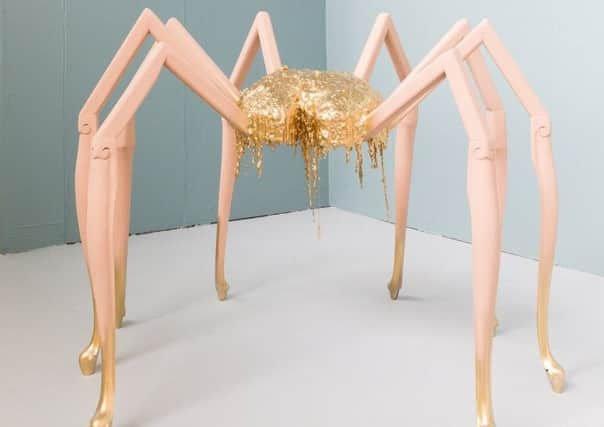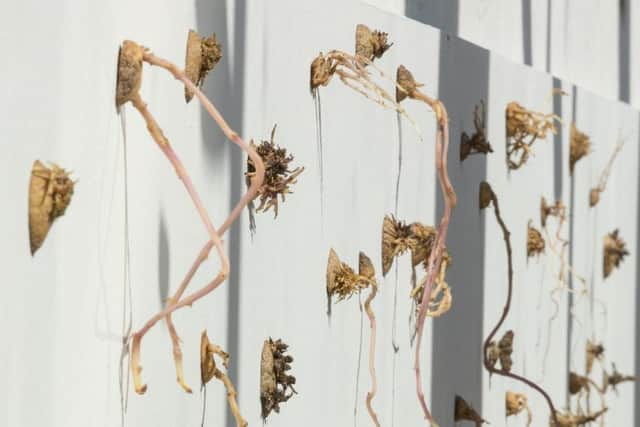Art review: Gray's School of Art Degree Show 2018


Art review: Gray’s School of Art Degree Show 2018, Gray’s School of Art, Aberdeen ****
I was raised in Aberdeenshire on a diet of (largely) potatoes, so I was delighted to see the work of Ashley Figgis, who has made her degree show entirely out of spuds. Surprisingly, they have some potential as an art material: the intriguing shapes of the roots and shoots, the way the material changes over time, making papery cases or pringle-shaped discs which can be stacked or made into chains. And, of course, the whole thing is biodegradable.
Advertisement
Hide AdYou don’t get much more down-to-earth than potatoes, but there are a number of students at Gray’s – as there have been at the other art schools this year – who are concerned about the lack of connection with down-to-earth physicality. This generation has grown up with the digital and virtual worlds and there is a sense of a desire to reconnect with physical things. Painter Hannah Gibson does it by making work which crosses into three dimensions, particularly using ceramics, while Jake Shepherd makes work in sculpture and film looking at how the real and virtual worlds overlay one another. Elsbeth Morrison’s films look at mortality, but with a sensuality which oozes with the physicality of life.


Another theme which is richly represented here, as it has been in the other degree shows, is the investigation of memory and the past. Printmaker Emma Laing looks at her family history by focusing on the cracks in the photographs, the gaps memory leaves. Elliott Cookson’s paintings are inspired by found photographs, capturing fragments, suggestions of meaning, as ephemeral as the memories themselves. Jade Gilbert picks up found objects – a doll, a child’s shoe, a pair of glasses – and slipcasts them in earthenware before returning them to the place they were found, making a collection of fragile things richly invested with meaning.
Painters Katie Avey and Yasmin Moore-Milne are both concerned with the process of how a memory is turned into a work of art. Avey paints the feelings she has as she unpicks a memory, representing them in colours and shapes. Moore-Milne notes that expressing a moment in painting changes it, investing it with a certain poetry and significance and taking it into a realm between truth and fiction.
Jennie Hastie looks at ruins of Second World War structures, now purposeless but still resonant with significance. She works with the forms, abstracting shapes from them and working with distressed surfaces including old wood and rusting metal. Joey Sim looks deep into the landscape, creating paintings shaped like stones with a complex layering of colour and texture.
Jess Wilson-Leigh makes the simple but important point that human beings shape our environment to suit ourselves, so she has created one which responds to us as we walk through it. Deni Black addresses questions about the contradictory way we relate to animals in large-scale paintings of inflatable cows, pigs and killer whales.
A number of students explore particular communities. Christopher Farrell’s bold figurative paintings are accompanied by a performance which brings out a narrative about one place particular to him. Jamie Dyer has an interest in tower blocks, celebrating the beauty in concrete and steel in photography and film. Rachel Thomson is interested in surveillance and, in a slightly spooky but very effective show, reports on the activities of her neighbours.
Advertisement
Hide AdAt Gray’s, sculpture is now part of a course called Contemporary Art Practice, along with printmaking and photographic and electronic media. However, there are still a number of students working sculpturally: Kyrsten Webster plays with the ideas of hard and soft materials, resting pastel-coloured concrete blocks on big furry cushions. Ilona Butter’s interest in the body has led to a family of “Bettys”, cuddly creatures which make a whimsical, pleasant gathering, while Phoebe Banks has made a “family” of polystyrene sculptures on wheels which take on more personality the longer one spends with them.
Ryan Watson says his work is inspired by failure: his failure to become either a successful architect or a great landscape painter. But his striking geometric abstract paintings draw richly on both. Sandy Scott takes the role of the trickster, championing the cause of a “lost” artist from the 1980s, Joseph (Joe) Kerr. Anna Tomsone started off with an interest in the speed of light and the theory of relativity, but has created a very effective show of collages and mirrors. Natasha Riddoch looks at the idea of home, and comes up with an installation of hand-made snails and a Louise Bourgeois-esque spider. Martin Richens’ painting has a political flavour, seen through the lens of a pop-art, graphic novel style.
Advertisement
Hide AdHere, writ small, is all the verve and variety one would expect from a degree show, but with more time to appreciate it than at some of the larger schools. I can think of no better way to conclude the degree show season in Scotland.
Until 24 June